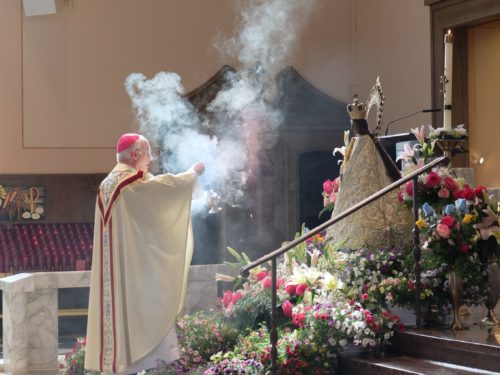
May is the month of the Virgin Mary, and Filipinos in the diocese and around the world honor her in their own special ways.
In Bayside, St. Robert Bellarmine parish hosted its annual diocesan celebration of Our Lady of Peace and Good Voyage, known to Filipinos as the “Birghen ng Antipolo” (Our Lady of Antipolo), on May 18.
The celebration began with a rosary in the afternoon and procession of Marian images to the church, followed by a flower offering to Our Lady and a Mass.
The Mass was celebrated by Auxiliary Bishop Raymond Chappetto, vicar general of the Diocese of Brooklyn, who shared his joy in being a part of “a really special annual night for the Filipino community.”
“To honor our mother in her special month of May is very important. It’s Mary’s month as the mother of God, and we rekindle our relationship to her, and her role in the plan of salvation,” Bishop Chappetto said in his homily. “How blessed we are to have her as our earthly mother, who cares for and loves us liked a mother loves her children.
“We honor her in the title of Our Lady of Peace and Good Voyage—if there’s one thing we need constantly in our world and in our church, it is peace,” the bishop concluded. “And we look to Mary for more peace, to guide us, even in stressful times. We ask Our Lady of Good Voyage to guide us.”
The Mass was filled with traditional Philippine culture and with music from Voices of Friendship Filipino choir. The readings were in both Tagalog and English, with a special blessing of the Marian image.
“Filipinos are a very Marian people our patron saint is the Virgin Mary, as Our Lady of the Immaculate Conception,” Father Godofredo Felicitas, associate pastor of St. Robert Bellarmine, told The Tablet. “Every night we pray the Angelus, and throughout the year, we celebrate different Marian traditions throughout the cities and barrios. Filipinos’ devotion to Mary, and all of her apparitions and images, is very strong.”
The history of Our Lady of Peace and Good Voyage dates back to the 16th century, during Spanish rule over the Philippines. Spanish traders making treacherous voyages across the Pacific Ocean from Mexico to the Philippines sought protection from the Blessed Virgin Mary, carrying with them statues and images of the Black Madonna from Mexico to keep them safe.
Because of her protection, the Black Madonna became the patroness of those expeditions, called “galleon trades,” and was named “Our Lady of Peace and Good Voyage” (Nuestra Señora de la Paz y Buen Viaje). Decades later, the image was reportedly left behind in a shrine in small town in the Philippines.
“The townspeople there have said the Marian image would disappear on several occasions from the small church where she was enshrined. They would always look for her, and find her atop the tipolo tree,” Father Felicitas said. A tipolo tree is a native plant in the Rizal region of the Philippines.
“When people asked, ‘Where is the Lady?’ The answer was always, atop the tipolo tree. And later, the word was contracted to ‘antipolo.’ The constant disappearance of the image from the chapel and her appearance on top of the tree was understood by people as a sign that she, Our Lady of Good Peace and Voyage, wanted a church built on the exact location of the tipolo tree.”
A church was built on the property, and the town was later named Antipolo, east of Manila in Rizal.
While the original Antipolo image is still in the Philippines, a replica of Our Lady was enshrined as a symbol of migrants to the United States at the National Cathedral of the Immaculate Conception in Washington, D.C. In early 1998, the Filipino-American community at St. Robert Bellarmine sponsored a smaller, wooden replica of Our Lady in their parish, with the support of Msgr. John Lavin, the Brooklyn diocese and other national and local Filipino organizations.
In October 1998, Our Lady of Antipolo–the second bonafide image in the United States, after the one in Washington–was enshrined under the authority of then-Bishop Thomas Daily. That was the starting point for St. Robert Bellarmine’s annual celebration of the Birghen ng Antipolo feast day in May.
Photos from the 15th annual Birghen ng Antipolo Feast Day in Bayside, Queens. (Photos: Allyson Escobar)
The Filipino community at the parish had been preparing for this year’s celebration for weeks, along with various Filipino communities and parishes across Queens, which hosted nine weekly novena prayers leading up to the event.
“It became a diocesan-wide event, especially for the Filipino community, whose devotion to Our Lady of Antipolo is historically strong,” said Ray Soto, a St. Robert’s parishioner and emcee for the reception. “We try and invite every parish and Filipino ministry around the neighborhood.”
A reception following the Mass featured traditional Filipino food and performances.
“It’s beautiful to see all of the Filipino regalia, language, music and costume as we honor Our Mother,” added Hermes Allas, a parishioner and adviser to the diocese’s Filipino apostolate.


















